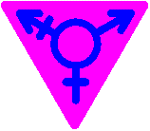 In June, 1997, a workshop on the legal needs of the non-transsexual
was held at ICTLEP. See the
transcript.
(At right, Jackie Thorn, Jane Ellen Fairfax, Mary Ann Horton, Melissa
Dixon at ICTLEP.)
In June, 1997, a workshop on the legal needs of the non-transsexual
was held at ICTLEP. See the
transcript.
(At right, Jackie Thorn, Jane Ellen Fairfax, Mary Ann Horton, Melissa
Dixon at ICTLEP.)
 Most efforts to protect transgender workers
have focused on transsexuals. Transsexuals must either change jobs
or visibly transition in the workplace, so they have the most on the line.
Crossdressers are usually able to confine their crossdressing to personal
time.
Most efforts to protect transgender workers
have focused on transsexuals. Transsexuals must either change jobs
or visibly transition in the workplace, so they have the most on the line.
Crossdressers are usually able to confine their crossdressing to personal
time.
But life is not rosy for the closeted crossdresser. We llive in fear of being recognized while out dressed, or of being discovered. We spend energy finding ways to lie about our weekend activities. We are afraid to pierce our ears, shave our legs, shape or polish our nails, or style our hair, because someone might figure it out. The first step to civil rights for crossdressers is not to have to fear firing or harassment if our transgender status becomes known. This is why a nondiscrimination clause is so important.
Some states and cities have codified this protection into local civil rights laws. While the courts have not yet interpreted laws such as those in Minnesota or New Orleans, it is generally believed that it would be illegal in those places to fire someone for crossdressing off the job. If the law also protects housing and public accomodations, it stands to reason that you cannot be denied housing or services based on your gender presentation, unless another law conflicts. Such laws have not been tested to determine if they protect restroom rights, but it is generally believed that restroom laws override civil rights laws. You still can't pee in a public restroom while crossdressed, if a local law forbids it.
Think about what happens if a crossdresser is on call at all times and carries a pager. Perhaps she is responsible for keeping a computer system running, and can be paged if the system crashes at night and requires attention. If the person is crossdressed when paged, a reasonable compromise is needed. The system must be repaired quickly, and it should not be necessary to change to perform the emergency work, even on the job site. But a physician who is paged while crossdressed might have to see a patient, whose health depends upon a professional appearance by the doctor. Perhaps some day patients won't be bothered by seeing their doctor respond to an emergency page in nontraditional attire.
The top priority for protection of crossdressers is that they not be fired or harrassed for off-the-job crossdressing.
Some dress codes are sex-specific. Men may be required to wear a necktie, for example, and women either a dress, suit, or pants suit. This is legal, and while not perfect, is a common requirement in today's culture. The usual reasons for sex-specific dress codes are to meet customer expectations, avoid disrupting the workplace, or match cultural norms. All of these reasons, of course, vanish when cultural norms become more relaxed. We hope to see sex-specific dress codes become a thing of the past.
Other dress codes are worded so they apply to both men and women. Dress codes for safety reasons, or for productivity, can apply equally to both genders. One well-worded dress code specifies "shirts with collars." An auto factory requires, for safety reasons, "No shorts, skirts, or open toe shoes." A dress code that permits skirts can be worded so that it permits anyone to wear a skirt: "Long pants or skirts, no shorts allowed" applies to everyone. Men in some workplaces with this sort of dress code sometimes wear skirts for comfort in hot weather when shorts are deemed too informal.
Uniforms are sometimes required of everyone in a workplace. UPS employees, both men and women, wear uniform coveralls. This is not sex or gender discrimination: it's OK because the same rules apply to everyone.
We would like to see continued relaxation of sex-specific dress codes in the workplace.
Some day, people may be permitted to freely express their gender at work, without pressure to conform to sex-based cultural stereotypes. Feminine men and masculine or agressive women will be valued for their contributions, not judged by their looks or mannerisms.
Surveys of gay, lesbian, and bisexual employees have asked them if they were discriminated against in employment for their sexual orientation (who they love) or their gender expression (how they look or act.) Large numbers of GLB people suffering discrimination reported discrimination based on gender expression, alone or in combination with their sexual orientation. One survey found 37% suffered such discrimination, another found 76%! The Price-Waterhouse decision suggests that such discrimination based on cultural sex stereotypes may be illegal, and is certainly counter to maximum employee productivity.
 In June, 1997, a workshop on the legal needs of the non-transsexual
was held at ICTLEP. See the
transcript.
(At right, Jackie Thorn, Jane Ellen Fairfax, Mary Ann Horton, Melissa
Dixon at ICTLEP.)
In June, 1997, a workshop on the legal needs of the non-transsexual
was held at ICTLEP. See the
transcript.
(At right, Jackie Thorn, Jane Ellen Fairfax, Mary Ann Horton, Melissa
Dixon at ICTLEP.)
.
.
 The first, experimental, occasional Twin-Peaks style
workplace crossdressing is being tried.
Mary Ann's first day on the job.
The first, experimental, occasional Twin-Peaks style
workplace crossdressing is being tried.
Mary Ann's first day on the job.
.
.
.
.
.
.